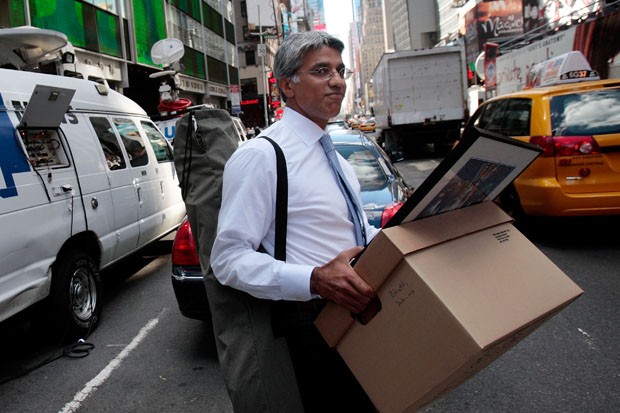Crash Course: 4 Investing Lifesavers for the Next Perfect Storm

Five years ago the failure of Lehman Brothers slammed Wall Street with an epic storm from which it is still recovering. For investors, there appeared to be no way out when the calamity hit, but five years after the collapse we know more about how to prepare for the next one.
“Markets are going to tank again, and you don’t know when and by how much, but it will happen,” says Mitch Tuchman, managing director of Rebalance, a retirement investment advisory service. “It’s like being out in a boat. There are going to be sunny days and stormy days.”
What is the biggest lesson five years after the Sept. 15 Lehman bankruptcy? “More money came out of equities than ever before. And that is exactly when people should have been investing,” Tuchman says. We know now that the old wisdom to “buy when there is blood in the streets” held true even as the financial crisis erased half of all global equity value in a few short months in late 2008 and early 2009. After all, stocks are flirting with new highs now.
The crash strongly affirmed another bedrock principle: Diversifying your holdings will limit your losses from one sector or asset class. If you held only bank stocks, or had no bonds, you lost a lot more than those who had a simple mix of equities and bonds. Wall Street’s broad averages have since recovered, as have most equity markets around the world.
With the anniversary of the crash looming, here are four key reminders to help you protect yourself from the next financial storm:
1. Know exactly what level of losses you can live with.
This can be quite literal. If you are 60 years old and plan to start living on your retirement fund, your investments should be very liquid, like short-term bonds. If you are younger, they can be more speculative. But it’s also important to gauge your emotional state. How much risk can you tolerate? Look carefully at the potential risk related to each investment you own.
2. Get really, really diversified.
Even more so now than in 2008, exchange-traded funds and index funds offer the chance for any investor to own a wide range of stocks. Even Standard & Poor’s 500 index might be too concentrated. Remember, its mix of assets was more than 20 percent financial stocks before the 2008 crash and 30 percent technology stocks in 2000 before the dot-com bust. The declines in those sectors of 80 percent to 90 percent hit the broad averages hard because they represented a big share of the market capitalization. Rebalance’s Tuchman says knowing what sector will be the next to bust is nearly impossible to predict, so invest as broadly as you can. “We think of it as owning thousands of stocks and bonds all over the world,” he says. “Markets usually recover, but not all sectors. So it’s best to own as wide a range as you can.”
Anton Bayer, CEO of the financial planning firm Up Capital Management, has a twist on that diversification strategy, which he says can lead to lackluster returns. For investors who feel confident they have researched a strong investment, they can use wide diversification for much of their portfolio, and research a handful of other investments to add some extra returns. That means broad-based ETFs, plus a handful of well-researched stock picks that have the potential to outperform.
3. Don’t pick market tops or bottoms.
“The statistical evidence is that most human beings never get this right,” Tuchman says. “Emotions get in the way, and people put money in when they are optimistic and take it out when they are pessimistic. That’s exactly the reverse of how markets work.” While it’s true if you invested at the S&P 500 low in 2009 just when the market was most depressed, you would have more than doubled your investment, it’s a skill few investors actually possess. For most people, there is more value in simply staying the course. Investors who did nothing and kept diversified equities holdings intact have recouped their crash losses.
Both strategists agreed that this does not mean you can ignore your portfolio entirely. It’s important to rebalance your holdings regularly to avoid holding positions that are too large in any given asset class, including those most vulnerable to a fall. In any big market downturn, there will be lasting damage. That’s another “teachable moment” from the 2008 crash. The bank stock sector is still about half the level it was before the crash based on the KWB Bank Index. Also, you can’t ignore broad trends in the market that threaten large chunks of the assets you hold. For example, the prospect of rising interest rates in the coming months suggest that you should hold more equities and fewer bonds.
4. If it sounds too good, you probably don’t know everything you should.
Mortgage securities fans were aggressively buying those toxic assets ahead of the crash to get an attractive yield with surprisingly strong credit ratings. They forgot to ask why those ratings stayed high when home loans were going into default. “Just because it sounds like a great investment doesn’t mean that it’s a mistake,” Bayer says. “But it does raise a red flag.” Watch out for suspiciously high returns, opaque accounting, securities that can’t be traded and stories that are “too unique,” he says. Some good investments might fit those criteria and turn out OK. But if you are not sure what it is that makes them so hot you run a risk of getting burned. Right now, highly specialized investments such as private, non-exchange-traded securities and others related to “crowdsourced” funding are becoming popular, but they require some serious due diligence.
What Went Wrong, and What’s Still Wrong
It helps to understand what went wrong with Lehman and the banking system. A simple picture will do: Wall Street was like the run on the Bailey Savings & Loan in the movie “It’s a Wonderful Life” when Bedford Falls folk sensed trouble and got scared. The 2008 crash was not a panic of individual investors, but of institutions and professionals who lost their trust in banks. There are still doubts about the financial underpinnings of major financial institutions, and the crash showed they can’t always sustain risk without government help. Despite regulatory responses, systemic risks could still threaten the market and economy. In the next such crises, no one can assume the government will bail out any bank large enough to threaten the financial system.
When no one came to the rescue for Lehman five years ago, a stampede began as investors started dumping nearly every security on every market in the world. In hindsight, we know not all of those stocks deserved to go down so much and most have recovered. But volatility will likely be the market’s one constant. Advisors say it’s best to keep your sails trimmed for any kind of weather.






